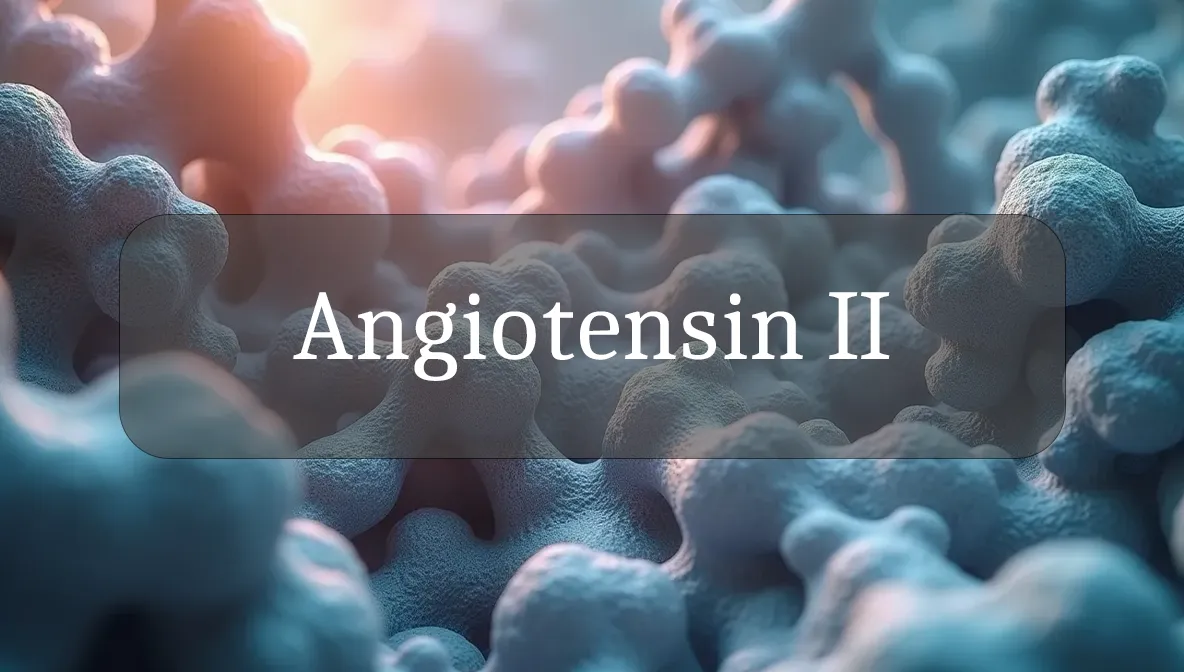Blood Pressure and Fluid Balance Regulator
Angiotensin II is like your body’s pressure valve, a potent peptide hormone that regulates blood pressure, fluid balance, and cardiovascular health. Produced as part of the renin-angiotensin-aldosterone system (RAAS), it’s a key focus for health-conscious folks aiming to maintain heart and kidney wellness. Understanding angiotensin II can empower you to make choices that support your cardiovascular system. Let’s explore what angiotensin II is, why it matters, and how you can optimize its function for daily vitality!
Chemical Identity and Type
Angiotensin II is an octapeptide hormone (8 amino acids, Asp-Arg-Val-Tyr-Ile-His-Pro-Phe) formed from angiotensin I by angiotensin-converting enzyme (ACE) in the lungs. Part of the RAAS, it’s generated when renin (from kidneys) cleaves angiotensinogen (from liver). It acts via AT1 and AT2 receptors, primarily in blood vessels, kidneys, and adrenal glands. Think of angiotensin II as a swift messenger, tightening vessels and balancing fluids to keep your system stable.
Biological Role and Benefits
Angiotensin II is critical for cardiovascular and fluid homeostasis, offering these evidence-based benefits:
- Blood Pressure Regulation: It constricts blood vessels, raising blood pressure (studies show it increases systolic BP by 10–20 mmHg in acute settings), vital during dehydration or blood loss.
- Fluid Balance: Stimulates aldosterone release, promoting sodium and water retention in kidneys, maintaining blood volume (RAAS activation retains 1–2 L water/day).
- Kidney Function: Regulates glomerular filtration rate, ensuring efficient waste excretion and fluid balance.
- Heart Support: Enhances cardiac output by increasing vascular resistance, supporting circulation under stress.
- Thirst Response: Triggers thirst and vasopressin release, encouraging water intake to restore hydration.
Balanced angiotensin II activity maintains blood pressure, fluid levels, and heart function, enhancing vitality.
Dietary or Natural Sources
Angiotensin II is produced endogenously, not consumed. Diet and lifestyle support its regulation:
- Sodium-Moderate Foods: Vegetables, lean meats, and whole grains (1,500–2,300 mg/day sodium) prevent RAAS overdrive, found in processed foods like canned soups or chips.
- Potassium-Rich Foods: Bananas, spinach, and avocados (2,500–4,000 mg/day potassium) lower blood pressure, balancing RAAS activity (studies show 1,000 mg potassium reduces BP by 4–5 mmHg).
- Magnesium-Rich Foods: Nuts, seeds, and dark leafy greens (300–400 mg/day) support vascular health, easing angiotensin II’s vasoconstriction.
- Hydration: Water (2–3 L/day) prevents dehydration, reducing RAAS activation and angiotensin II spikes.
- Omega-3s: Salmon or walnuts (1–2 g/day) reduce inflammation, supporting vascular response to angiotensin II.
A balanced diet promotes healthy RAAS function and angiotensin II regulation.
Signs of Imbalance or Dysfunction
Angiotensin II imbalances, often tied to RAAS overactivity or suppression, may manifest as:
- High Angiotensin II (RAAS Overactivity):
- Hypertension (high blood pressure, >140/90 mmHg, linked to RAAS in 20–30% of cases).
- Fluid retention (swelling, edema, or heart strain).
- Headaches, fatigue, or dizziness from elevated BP.
- Low Angiotensin II (RAAS Suppression, e.g., ACE inhibitors):
- Hypotension (low BP, <90/60 mmHg, causing dizziness or fainting).
- Dehydration or electrolyte imbalances, like high hyperkalemia (potassium >5.0 mmol/L).
- Kidney dysfunction (e.g., in renal artery stenosis).
- Related Conditions: Chronic kidney disease, heart failure, or hyperaldosteronism (Conn’s syndrome, 1–2% prevalence) amplify RAAS issues.
Persistent symptoms require medical evaluation (e.g., renin, aldosterone, BP monitoring).
Supporting Optimal Levels or Function
To balance angiotensin II and RAAS, try these evidence-based tips:
- Limit Sodium: Cut sodium to 2,300 mg/day (e.g., swap salt for herbs like rosemary to reduce processed food intake); to lowers BP in 50–60% of hypertensives.
- Boost Potassium: Eat oranges or sweet potatoes for potassium to counteracts angiotensin II’s effects (diets with >3,500 mg/day reduce hypertension risk by 20–25%).
- Stay Hydrated: Drink 2–3 L/day to avoid dehydration, minimizing RAAS activation.
- Exercise Regularly: Aerobic exercise (30 min/day, 5 days/week) lowers BP by 5–30 mmHg in and reduces RAAS activity in 60–80% of individuals.
- Manage Stress: Meditation or deep breathing (10–20 min/day) lowers cortisol, which can amplify RAAS.
Small, consistent habits promote balanced angiotensin II function.
Safety, Interactions, and Precautions
Angiotensin II is natural but imbalances pose risks:
- Medical Conditions: Hypertension, heart failure, or kidney disease amplify RAAS; primary aldosteronism (5–10% of hypertensives) requires specialized care.
- Medications: ACE inhibitors (e.g., lisinopril) or ARBs (e.g., losartan) block angiotensin II, used in 30–40% of hypertensives; monitor for hypotension or hyperkalemia.
- Supplements: Licorice root raises BP by mimicking RAAS; avoid in hypertension. Potassium supplements risk hyperkalemia with RAAS inhibitors.
- Pregnancy: Angiotensin II blockers are contraindicated; they cause fetal harm (e.g., kidney defects in 1–5% of exposed fetuses). Use alternative BP meds.
- Allergies: Rare reactions to ACE inhibitors (e.g., angioedema, 0.1–0.7%) require immediate medical attention.
Consult a healthcare provider for cardiovascular or kidney concerns.
Fun Fact
Angiotensin II is so powerful it can raise your blood pressure faster than a sprint! In seconds, it tightens vessels, ensuring your body stays primed even during a sudden drop in blood volume.
Citations
- National Institutes of Health (NIH): Renin-Angiotensin-Aldosterone System.
- American Heart Association: Hypertension Management.
- Mayo Clinic: High Blood Pressure and RAAS.
- Cleveland Clinic: Nutrition and Cardiovascular Health.
- USDA: Dietary Guidelines for Americans – Sodium and Potassium.

